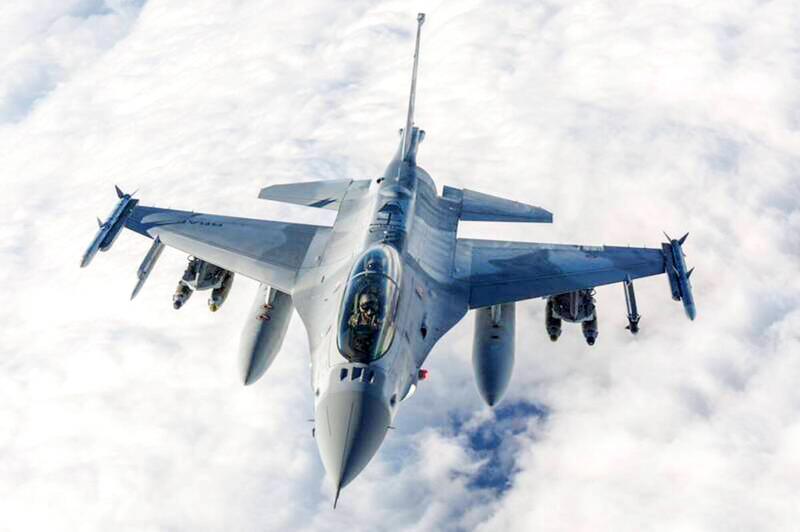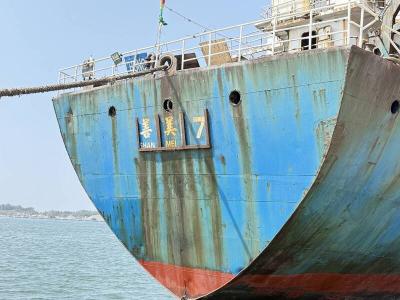The US has assembled the first of the 66 Lockheed Martin F-16C/D Block 70 airframes ordered by Taiwan, Minister of National Defense Wellington Koo (顧立雄) said yesterday.
Koo made the remarks on the sidelines of a meeting of the legislature’s Foreign Affairs and National Defense Committee on damage to undersea Internet cables reportedly inflicted by a Chinese ship.

Photo courtesy of the US Air Force
Asked to comment on the US delivery of arms to Taiwan, Koo said that aircraft from the order had been assembled and the two nations are working together to facilitate the process.
The ministry has dispatched a team to the US and is holding monthly teleconference calls to ensure the jets would obtain the relevant certifications in two months, he said.
The ministry was heartened by comments from US president-elect Donald Trump’s presumptive national security adviser Mike Waltz that the incoming administration is committed to the speedy delivery of arms to Taiwan, he added.
The delivery of the long-awaited multiple-role fighters has been repeatedly delayed by supply chain woes that pushed the expected delivery date from the fourth quarter of last year to March this year.
Koo in October last year said 19 of the F-16C/D Block 70 jets slated to be delivered to Taiwan were in the pipeline and all 66 are expected to be delivered by next year.

An undersea cable to Penghu County has been severed, the Ministry of Digital Affairs said today, with a Chinese-funded ship suspected of being responsible. It comes just a month after a Chinese ship was suspected of severing an undersea cable north of Keelung Harbor. The National Communications and Cyber Security Center received a report at 3:03am today from Chunghwa Telecom that the No. 3 cable from Taiwan to Penghu was severed 14.7km off the coast of Tainan, the Ministry of Digital Affairs said. The Coast Guard Administration (CGA) upon receiving a report from Chunghwa Telecom began to monitor the Togolese-flagged Hong Tai (宏泰)

A cat named Mikan (蜜柑) has brought in revenue of more than NT$10 million (US$305,390) for the Kaohsiung MRT last year. Mikan, born on April 4, 2020, was a stray cat before being adopted by personnel of Kaohsiung MRT’s Ciaotou Sugar Refinery Station. Mikan was named after a Japanese term for mandarin orange due to his color and because he looks like an orange when curled up. He was named “station master” of Ciaotou Sugar Refinery Station in September 2020, and has since become famous. With Kaohsiung MRT’s branding, along with the release of a set of cultural and creative products, station master Mikan

RISING TOURISM: A survey showed that tourist visits increased by 35 percent last year, while newly created attractions contributed almost half of the growth Changhua County’s Lukang Old Street (鹿港老街) and its surrounding historical area clinched first place among Taiwan’s most successful tourist attractions last year, while no location in eastern Taiwan achieved a spot in the top 20 list, the Tourism Administration said. The listing was created by the Tourism Administration’s Forward-looking Tourism Policy Research office. Last year, the Lukang Old Street and its surrounding area had 17.3 million visitors, more than the 16 million visitors for the Wenhua Road Night Market (文化路夜市) in Chiayi City and 14.5 million visitors at Tainan’s Anping (安平) historical area, it said. The Taipei 101 skyscraper and its environs —

Taiwan on Friday said a New Zealand hamburger restaurant has apologized for a racist remark to a Taiwanese customer after reports that it had first apologized to China sparked outrage in Taiwan. An image posted on Threads by a Taiwanese who ate at Fergburger in Queenstown showed that their receipt dated Sunday last week included the words “Ching Chang,” a racial slur. The Chinese Consulate-General in Christchurch in a statement on Thursday said it had received and accepted an apology from the restaurant over the incident. The comment triggered an online furor among Taiwanese who saw it as an insult to the